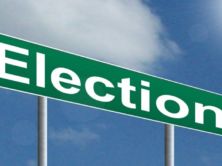
(Credit: George Hodan/https://www.publicdomainpictures.net/)
This month, American University Professor Allan Lichtman made his widely anticipated prediction of who would win the 2020 presidential election. Touted as the “historian who has accurately called every election since 1984”, as the “lone man who predicted Trump would win in 2016”, and as the “election forecasting guru…who has correctly predicted the results of every presidential election since 1984”, Lichtman announced in an interview with the New York Times that Biden would beat Trump.
Last year, Lichtman spoke about his 2016 prediction that Trump would win the election, and compared it with the polling predictions of a Clinton win. In an interview with The Washingtonian, he said:
“My system is totally different from what 538 does, Nate Silver, the guys at Princeton, their consortium. What they do is just compile polls, and polls aren’t predictors. Polls are just snapshots. They don’t predict anything. Because polls always change, and they keep changing. They just compile polls. That’s why they were so wrong in 2016. My system is based on a theory of how presidential elections actually work. Not just a mindless compilation of polling data.”
When asked by the interviewer whether the last minute announcement by James Comey, that the FBI would reopen an investigation into Hillary Clinton’s emails, had any effect on the election outcome, Lichtman pushed back.
When you looked at flawed data, you reach flawed conclusions. The fact that I was able to predict it [the election] before James Comey should tell you everything you need to know.
The fact is, Lichtman’s model did not predict that Trump would win the presidency. It really predicted that Trump would win the popular vote.
It’s an inconvenient fact that Lichtman will not acknowledge, as numerous media stories tout his unblemished record.
When I challenged him about his claim, he was adamant that his model had been correct in predicting the 2016 winner. But, as I outline below, for a model to predict an election, its elements and interpretations must be established before the election, not afterward. Lichtman’s new interpretation of his model — that it changed from predicting the popular vote to predicting the electoral vote — was not announced until after Trump had won the presidency.
Problem with Lichtman’s Model and the Electoral College
Lichtman’s model is based on the general theory that every presidential election is fundamentally a referendum on the incumbent party. If the party has done well, its candidate will win the election. Otherwise, the challenger will win.
To measure how the public views the party in power, Lichtman has developed several “keys” – factors that influence the electorate’s perceptions. Eight of those 13 keys deal specifically with the current administration’s performance, two deal specifically with the character of each major candidate, and three deal with the election process.
Of those 13 keys, if the current administration fares badly on six or more, its party will lose the election.
But it’s not really that the party will lose the election. It’s rather that the incumbent party will lose the popular vote. There is nothing in the 13 keys that address the possibility that the winner of the electoral college and the winner of the popular vote might not be the same person. And Lichtman has explicitly acknowledged this point.
Here is what he wrote in the introduction to the 2008 edition of his book The Keys to the White House: A Surefire Guide to Predicting the Next President (Rowman & Littlefield Publishers, 2008). Emphasis is mine:
“The Keys to the White House focus on national concerns such as economic performance, policy initiatives, social unrest, presidential scandal, and successes and failures in foreign affairs. Thus, they predict only the national popular vote and not the vote within individual states.”
“In three elections since 1860, where the popular vote diverged from the Electoral College tally – 1876 (when Democrat Samuel J. Tilden won the popular vote, but lost in the Electoral College to Republican Rutherford B. Hayes), 1888 [when Democrat Grover Cleveland won the popular vote but lost to Republican Benjamin Harrison in the Electoral College], and 2000 [when Democrat Al Gore won the popular vote but lost to Republican George W. Bush in the Electoral College] – the Keys accurately predicted the popular vote winner.”
As these excerpts make clear, Lichtman has claimed that his model was accurate in predicting a Gore victory in 2000 (as well as suggesting victories for Tilden in 1876 and Cleveland in 1888), because the model indicated those candidates would win the popular vote – even though they lost the presidency.
And that characterization of his model had not changed when he made his 2016 prediction.
Lichtman’s Response
I wrote to Lichtman and indicated that I thought, contrary to his claims, his model had not accurately predicted the 2016 election, because – according to his 2008 book – the model only predicted the popular vote. And in 2016, Trump did not win the popular vote. Lichtman emphatically disagreed with my conclusion, saying that in 2016 he had never said anything about the popular vote, but had been very clear that based on the 13 keys, Trump would win the presidency.
Lichtman is correct in noting that, when making his 2016 prediction, he never said Trump would win the popular vote, only that Trump would become president.
But that is the same language he used in 2000, when he predicted that Gore would win the presidency. After the election, as noted above, he clarified what that prediction meant: The keys, according to his book, “predict only the national popular vote and not the vote within individual states.”
That clarification was not a post hoc rationalization, because his model had been developed by looking at elections from 1860 through 1980. As Lichtman noted (above), two elections in this time frame – in 1876 and 1888 – produced winners of the popular vote who did not win the presidency. And his model was consistent with predicting the winner of the popular vote, not the winner of the presidency.
Thus, when Lichtman argued in his 2008 book that his 2000 prediction for Gore to win the presidency was accurate, because the model had correctly predicted Gore to win the popular vote, his claim of accuracy was consistent with his model.
But that is not the case with the 2016 prediction, when his model did not correctly predict the popular vote winner. Yet, Lichtman still claims the prediction was accurate.
Changing the Model’s Interpretation
According to Lichtman, his model’s predictions have changed to indicate the actual winner rather than the popular vote winner because of a change in the demographics of the country. That explanation is provided in his new book, Predicting the Next President: The Keys to the White House (2020 edition). He also explained those changes in an interview on CNN with Michael Smerconish on Aug. 8, 2020:
Smerconish: “One asterisk: In the year 2000, you [predicted] Al Gore – and he did win the popular vote, and for this cycle now, you talk about Electoral College victory. Am I right?”
Lichtman: “Absolutely, because the dynamics have changed. The baseline is now that the Democrats automatically get 5 to 6 million extra votes in just two states – New York and California. Those votes count for zero in the Electoral College. So, the baseline is now the Democrats will win the popular vote in a close election, so I now only predict who’s going to win, which I did in 2016.”
Up until the 2016 prediction, as far as I knew, Lichtman had never gone public with any suggestion that his model had changed. So, I asked him very explicitly these questions:
- When did the model switch from predicting the popular vote to predicting the electoral vote?
- Was there anything about the model itself that changed so that it could make such a switch?
- If not, on what basis do you believe your model could now be used to predict the electoral vote when previously you said it was predicting the popular vote?
- When did you first write that the model had made such a change?
His answer to the first question is best found in this statement: “Obviously the divergence between the popular and electoral vote in 2000 after 112 years of convergence alerted me to the problem. However, it did not become a concern until 2016.” As he indicates, he didn’t worry about any change in his model’s predictions for the 2004, 2008, or 2012 elections, because he felt there was little possibility that the popular vote winner and the electoral vote winner would be different in those years. That possibility, he implies, was not a “concern” until 2016.
As for the second question, Lichtman has made it clear that the model did not change, only the interpretation of what it predicted. In an interview after the 2016 election, Lichtman explains that the dynamics of Democratic Party dominance in California and New York “didn’t change my keys, but kind of led to a rethinking of how I interpret the keys.”
The changed dynamics he cites also answers the third question. His model is exactly the same, he argues, but now – because of the changed dynamics – it predicts the actual winner, not necessarily the popular vote winner.
It is not a persuasive response. Nothing in the keys deals with the arcane American process involving the Electoral College. Moreover, as Lichtman makes abundantly clear, the underlying theory of the model is that it measures whether voters approve or disapprove of the incumbent administration. If they approve, voters will support the party in power; if not, they will support the challenging party. Nothing in that theory explains how the model will now predict the challenger to win, even if the people approve of the incumbent administration.
But my skepticism about the alleged change in the model is irrelevant in this case. For Lichtman to claim that he accurately predicted the 2016 election, he must have dealt with the change in his model before the election.
As for that fourth question, as to when he first announced the change in his model, this is what Lichtman wrote to me:
The divergence first became an issue for me in 2016 for these reasons. First, the Democratic structural advantage in New York and California had grown since 2000, from 1.7 million in 2000 to 5 million in 2012. Critically, 2016 was a very difficult knife-edge call that I did not make until much pondering on Sept. 23, 2016 in my Washington Post interview with a very difficult call on the third-party key. It was a call with just 6 keys against the incumbent Democrats. As I told the Post in my interview, the keys “very, very narrowly […] point to a Trump victory.” So, as we proved, in 2016, I just made the call for a Trump victory just as in 2020 I made the call for a Trump defeat.
Explanation. Here is what I said about my 2016 prediction shortly after the election in a Nov. 18, 2016 interview, which clearly validates how I have predicted 2020:… [Note: emphasis added]
I have not included his elaborated explanation, because it is essentially the same as what he had already written in the preceding paragraph above.
The important point is that Lichtman made the explanation about the change in interpreting his model after the election, not before. The earliest date he cited was that interview with Jessica Conditt of Engadget on November 18, 2016, eight days following Trump’s victory.
One cannot change a model after the fact and still claim it is a prediction. Lichtman’s new interpretation seems like a post hoc rationalization for why the model failed. And that’s okay. But the new interpretation is simply not a prediction.
All that said, Lichtman’s model has a surprisingly good record: Accurate predictions of the popular vote from 1984 through 2012, with a miss in 2016. Not perfect, but commendable.
UPDATED: 8/26/2020 11:15 AM
Below, Lichtman has responded to Moore’s commentary.
Response to David Moore
Allan J. Lichtman
Distinguished Professor of History
American University
Washington, DC 20016
David Moore validly notes that I should have made more clear prior to my 2016 prediction the rationale for why I was only calling a Trump victory, not a popular-vote plurality. Moore has no quarrel with this rationale, but only says I should have made it earlier. Fair enough. If he had stopped there, I would not have made this post. However, he goes on to misrepresent my work.
His central, misleading claim is that I made a change in my model to predict the winner “after the fact.” I did not change the model. I only changed the interpretation. His only evidence for an “after the fact” change is an interview I gave on November 18, 2016, explaining my rationale based on the changing political demographics of the nation. This proves nothing, except that this was the first time I was asked to provide the explanation. It defies logic to claim that it means that I shifted to predicting the winner “after the fact.” In a private email to me that does not appear in his post, Moore admits “let me acknowledge up front: Yes, you predicted a Trump victory in 2016. You did not say in any of your predictions that Trump would win the popular vote. You said only that he would win. You did not say in any of your predictions that Trump would win the popular vote.”
Moore fails to note that I was not the only forecaster to recognize that shifting circumstances required a change in the interpretation of a prediction model. The well-respected political science professor and forecaster Helmut Norpoth also switched to predicting the presidential winner, not the popular vote. According to an August 3, 2020 press release from his institution, Stony Brook: “One model change Norpoth has made for the upcoming election has been to focus on the Electoral College. ‘Now I predict straight to the Electoral College,’ he said. ‘I’ve never done that before, but I made an adjustment because of the mismatch we had in 2016.” This shift apparently came years after he took credit for correctly predicting Trump’s win in 2016. Like my model, Norpoth’s does not go state-by-state but references national trends.
Moore’s headline says that my book contradicts my correct 2016 prediction of a Trump win. However, the book he references is from 2008, not 2016, which the reader would have to dig through 552 words to find out. Yet, Moore claims that somehow my 2016 prediction was inaccurate based on what he thinks I meant to say or should have said.
Moore also ignores in his post the cites and quotes I provided him on the recognition by authorities in the field that I predicted correctly Trump’s win in 2016, not a lead in the popular vote. Examples include Gerald M. Pomper, arguably the Dean of American political science; Dennis W. Johnson, Professor Emeritus of Political Management, George Washington University; Patrick Horst, Institute for Political Science and Sociology, Bonn; John A. Tures, Professor of Political Science, LaGrange College; and Shankar Vedantam NPR’s resident science authority.
Moore admits in an email that his research uncovered only a single alleged piece of contradictory evidence: “In doing various searches about your predictions, I found one comment that seems to summarize in very concise terms what the problem appears to be.” Stacked against the array of authorities above, this evidence consists of a single, random, unidentified comment on an August 2020 Reddit post by someone with the handle tehfunnymans.
Moore falsely claims from my 2008 book that the language I used to predict Trump’s win in 2016 “is “the same language he used in 2000.” In fact, I noted in that book, “As predicted, Gore prevailed in popular vote.” I then explained in detail Gore’s election was stolen in Florida, so my prediction was correct in both regards.
Moore also references 1876 and 1988, the last times before 2000 when the popular and Electoral College votes diverged. But he ignores the explanation I provided him. I noted that “1876, like 2000, this was a stolen election. In fact, that is the title of my section on that election in my book.” I admitted that 1888 was “clearly an anomaly,” in a prediction that turned on one key. But, “even if I were wrong about 1888 it would not have changed how the Keys turned out in this developmental period.”
Moore further claims incorrectly that “nothing in that theory explains how the model will now predict the challenger to win, even if the people approve of the incumbent administration.” That is directly contrary to model which indicates that the challenger would win only if the people disapprove not approve of the incumbent administration. As I explain in a September 26, 2016 interview, well before the election, “The Keys point to a Donald Trump victory, and in general, point to a generic Republican victory.” (emphasis added)
I welcome the opportunity for a robust exchange of views. Yet, I find it odd that Moore relies on a twelve-year old version of my book and waits nearly four years and only after I predicted a Trump 2020 loss, to critique my 2016 prediction. Despite his faint praise at the end about my success only through 2012, I stand by my 2020 prediction of a Trump defeat, which is the only one that counts right now.
UPDATED 8/26/2020 5:15 PM:
Response from David W. Moore:
There are a lot of red herrings in Lichtman’s response to my article, in which I argue that he did not predict Trump to win the electoral vote in 2016. My principal argument is that until the 2016 election, Lichtman had always claimed that his model predicted the popular vote winner, not the electoral vote winner. Even when he would say, for example, Gore will win the presidency, he meant that Gore would win the popular vote – not necessarily the presidency.
That was his position, very clearly stated in his 2008 book, when he claimed that his prediction of the Gore victory was accurate, because “The Keys to the White House focus on national concerns such as economic performance, policy initiatives, social unrest, presidential scandal, and successes and failures in foreign affairs. Thus, they predict only the national popular vote and not the vote within individual states.”
In short, until the 2016 election, Lichtman made it clear that his prediction of “victory” meant the candidate would win the popular vote, regardless of whether the candidate won the presidency.
Thus, when he predicted a Trump victory, it was certainly reasonable for anyone familiar with his work to interpret that prediction as saying that Trump would, at a minimum, win the popular vote. Indeed, had Trump won the popular vote and lost the electoral vote, there would have been no reason for Lichtman to announce any change to the interpretation of his model.
But in 2016, after his model failed to predict the popular vote, Lichtman announced that, oh yeah, the model now predicts the electoral vote winner. This new interpretation of his model had not been revealed to the public until he was interviewed by Jessica Conditt of Engadget on Nov. 18, ten days after the election.
In fact, the first paragraph of Lichtman’s response essentially agrees with my critique, when he writes: “David Moore validly notes that I should have made more clear prior to my 2016 prediction the rationale for why I was only calling a Trump victory, not a popular-vote plurality.”
Yes, that is exactly my point. Lichtman did not make clear that he was changing the interpretation of his model until after the election. Until then, according to Lichtman, it predicted the popular vote winner. After it failed to do that for the 2016 election, Lichtman announced that we should now interpret his model to predict the electoral vote winner.
Sorry, but that’s too late to count as an accurate prediction. At best, it’s a post hoc explanation of why the model failed.
Lichtman appears to misunderstand my argument, when he writes, “His central, misleading claim is that I made a change in my model to predict the winner “after the fact.” I did not change the model. I only changed the interpretation.
Wait! This is what I wrote in the article (see above): “Lichtman has made it clear that the model did not change, only the interpretation of what it predicted.”
Then Lichtman writes: His only evidence for an “after the fact” change is an interview I gave on November 18, 2016, explaining my rationale based on the changing political demographics of the nation.”
Yes, that is pretty substantial evidence, provided by Lichtman himself. In my correspondence with him, I asked directly when was the first time he had publicly revealed the change in the interpretation of his model. His only answer was to refer to that November 18, 2016 interview, eight days after the election.
So, essentially he agrees with me, regardless of all the other comments he makes in his response.
The key here is this: When did Lichtman first claim that his model had changed from predicting the popular vote winner to predicting the electoral vote winner?
Even Lichtman agrees – it wasn’t until after the election.
The rest of Lichtman’s response is mostly a red herring, as well as misinterpretation of our correspondence.
Yes, a lot of people, apparently not familiar with Lichtman’s models, took his prediction of a Trump victory literally. Yes, Helmut Norpath decided to change his model because of changing dynamics, though there’s no evidence other statistical models did so. But that has nothing to do with failing to note changes in a model before the election.
Yes, I do question how Lichtman justifies his model now. Previously, he had argued that an election was a referendum on the incumbent administration. If people approved of it, they would vote in that party’s candidate. If they disapproved, they would vote in the challenger. But in 2016, the public approved of the Obama administration (as reflected in the popular vote), yet the challenger won. What theory does the Keys to the White House now depend on?
Finally, Lichtman makes an argument that seems out of character with a distinguished professor. “I find it odd that Moore relies on a twelve-year old version of my book and waits nearly four years and only after I predicted a Trump 2020 loss, to critique my 2016 prediction.”
When arguments fail, question the critic’s motives.
I explained to him that I had first become aware of his new interpretation of the model when he made his 2020 prediction. Yes, he made the 2016 prediction four years ago, but I wasn’t following closely enough to realize that he had changed the interpretation of his model only after the election. That realization came when I heard his 2020 announcement.
As for relying on a twelve-year old version of his book – yes, because it clearly outlined how he interpreted his model following the 2000 call for Gore, an approach that he had not changed until after the 2016 election. What is wrong with that?
All this said, I want to reiterate that overall, I find Lichtman’s model quite insightful. Several of the keys are highly subjective, but still Lichtman has used the 13 keys to provide interesting assessments of an incumbent administration. And he has been accurate in predicting the popular vote winner from 1984 through 2012.
I look forward to seeing how his new interpretation fares should the country once again face the possibility of a divergence between the popular vote winner and the person who becomes president.





